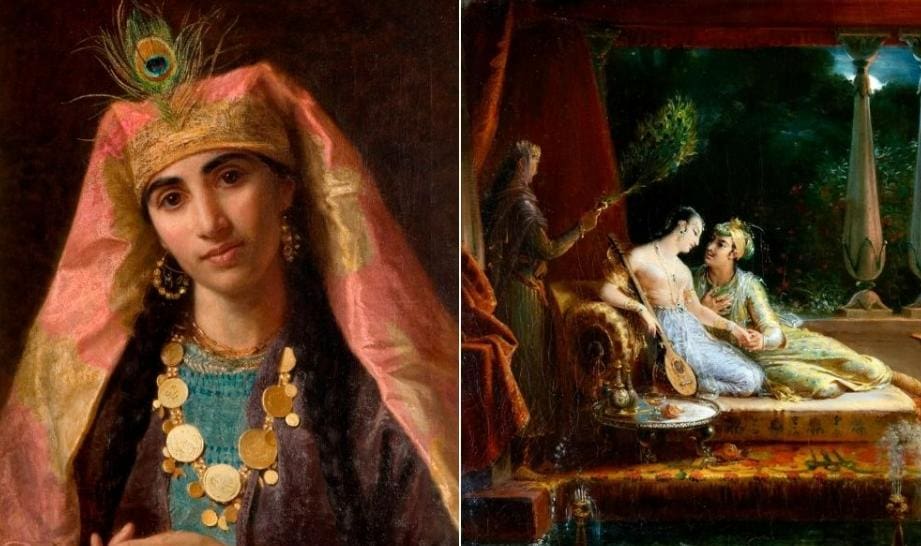Every culture has legends and narratives. Some of them are full of particularly strong women. Here are strong women from folklore and mythology.
Mythologies and folk legends around the world are filled not only with heroes and monsters, but also with strong and inspiring female characters. These legendary figures both question social norms and celebrate women’s strength and intelligence. Scheherazade’s strategic intelligence, La Diablesse’s enchanting yet dangerous nature, Grýla’s frightening abilities, and others show how women are prominent in cultural narratives and how they shape their roles in myths. In this article, we will explore how these female characters are shaped by both historical and cultural contexts, how they challenge societal norms and how they feature as an important part of folk legends. Here are powerful women in folklore and mythology from around the world…
Scheherazade

We are starting our article on strong women in folklore and mythology. Scheherazade is one of the main characters of the Thousand and One Nights. These tales include folk tales of the Middle East and Asia and are known for famous characters such as Aladdin, Ali Baba, Sinbad. However, Scheherazade often does not receive enough attention, despite being at the center of these stories.
The story of Scheherazade begins with a cruel Sultan, Shahriyar. When the Sultan finds out that his wife has been unfaithful, he has her executed and decides to marry a new woman every day and kill her the next day, blaming all women. This practice continued for three years. Then Shahrazad, the daughter of the Sultan’s vizier, offered to marry Shahriyar.
On the wedding night, Scheherazade wants to say goodbye to her younger sister and tells her a story. As the story continues, morning comes, but Sultan is curious to know the end of the story, so he allows Scheherazade to continue telling it. In this way, as she continues to tell a new story every night, the Sultan falls in love with Scheherazade and allows her to continue this habit. In the end, Scheherazade saves her own life and the lives of other women with her intelligence and courage and marries the Sultan. Beyond traditional female characteristics such as beauty and obedience, she stands out as a strong and intelligent character. She is therefore an important role model for women.
La Diablesse

La Diablesse is a character from Caribbean folklore and can be translated as “the she-devil”. She is especially known in Trinidad, Tobago and Grenada. La Diablesse is described as a spirit said to lure men with her beauty and drive them to death. She is a tall, beautiful woman and men are so mesmerized by her presence that they often fail to notice that one of her legs is a cow’s hoof and that she smells of decay. Although she poses no threat to women or children, there are countless stories of how she lures men to their deaths. The story of La Diablesse aims to discourage men’s infidelity and excessive drinking. It is also interpreted as a cautionary tale, warning people about the dangers of the forest and wilderness.
Grýla

Grýla is a troll woman from Icelandic folklore and is particularly associated with Christmas time. Grýla makes a list of children who behave badly throughout the year and on Christmas Eve she collects them in her bag. She brings them to her cave and cooks them in a stew. Having killed her first two husbands, Grýla lives with her third husband Leppaludi and thirteen Yule Lads (Christmas Children). The Yule Lads do everything from mischief to torturing the natives.
Grýla’s story is used to encourage good behavior and warn children about winter conditions. The frightening nature of Grýla and her family subverts traditional family dynamics and serves as a warning about the dangers of the natural world.
Cihuateteo

Cihuateteo are defined as spirits from the other world in Aztec mythology. Cihuateteo are the spirits of women who die in childbirth, and these women are honored like warriors who died in battle. However, the Cihuateteos are not only revered but also feared, because according to mythology, five times a year they return to the land of the living and try to steal the children of others because they have no chance to raise their own. Adults who encounter a Cihuateteo can become insane or paralyzed. The Cihuateteo offers a warning about the dangers of both childbirth and having children. At the same time, the rituals associated with these spirits reflect people’s relationship with and fear of nature and spirits.
Nang Tani

We continue our article on strong women in folklore and mythology. Nang Tani is known as a spirit in Thai folklore. Nang Tani appears as a beautiful woman dressed in traditional clothes among wild banana trees. She appears during the full moon and sometimes brings good or bad luck.
Nang Tani’s purpose is disputed among the locals and she is said to be a spirit that avenges women who have been wronged by men, and is also the representative of sacred banana trees, which are essential for magic and medicine in Thai culture. However, there are also legends that she is a gentle spirit who protects the groves and brings bad luck to anyone who cuts down a banana tree.
Nang Tani is a figure that warns about the protection of the natural world and banana trees in particular. It also conveys a message about the power of nature and its impact on human life.
Mami Wata

Mami Wata, who has made a name for herself in recent years and won an award at the Sundance Film Festival in 2023, is an African water spirit and is associated with both the one god and many female figures.
Its origins are widely debated. While it appears in West Africa and is sometimes assumed to be thousands of years old, others suggest that it comes from the time of European and American imperialism in Africa. Some suggest that its name comes from Pidgin English and means “mother water”, while others claim that its name is of Ethiopian origin.
Mami Wata is often depicted as a mermaid or snake and is associated with fertility. She can be both a protective spirit and cruel, leading to infertility, especially due to the egoistic behavior of women. He also has a deep association with combs and mirrors. As a patron deity, it seems unsurprising that his cult was brought to America by captive slaves, and is even said to have capsized slave ships. The story of Mami Wata provides a warning about the dangers of wealth and water. At the same time, Mami Wata’s benevolent and protective nature allows her to be seen as both a dangerous and prosperous spirit.
Glaistig

Glaistig is a type of fairy or ghost from Scottish mythology. Glaistig is often described as a beautiful woman with the lower body of a goat. Glaistig is known as both benevolent and malevolent, with many variants coming from local folklore across the country. In some cases he protects herds of deer and only allows hunters to see the herd if they make an offering to him. In other traditions, he is known to throw stones to throw travelers off their route and even drink their blood as a kind of succubus.
In some local tales, Glaistig or the Green Woman is also said to do housework at night in exchange for milk. She is thought to be directly linked to the Banshee, a kind of fairy whose scream brings death. Glaistig represents Scotland’s changeable weather and the dangers of the wilderness. He is also seen in Scottish folklore as both a helpful and dangerous character.
La Madre Monté

La Madre Monté is a spirit from Colombia. La Madre Monté is often seen as the protector of the forests. It means “Mother Mountain” in Spanish and manifests itself in various forms. It protects those who live in the forest, but prevents damage to the forest. She appears during violent storms and her presence in the forest can cause people to lose their way. Her images range from a tall, beautiful woman to an old woman with bright red eyes and even vegetation. She is said to surprise those who enter the forest and disturb those who wish to harm it. La Madre Monté maintains the natural order in Colombia’s forests and promotes respect for the natural world. Moreover, as a powerful representative of nature, she is both a protective and punitive figure.
Meng Po

Meng Po is an important figure in Chinese mythology and is often depicted as an old woman. In Chinese, the term “Meng Po” means “goddess of forgetfulness”. This figure has an important role in Diyu, the Chinese underworld. Diyu is considered the place of the afterlife and the place where souls are punished. According to Chinese culture, people pass through this place after death, where they face various punishments. These punishments vary depending on the person’s behavior in the world, such as being tormented by snakes for years.
Meng Po is usually known as a figure waiting at the ninth or tenth court of Diyu. At these courts, souls are offered Meng Po soup to help them forget memories of their past lives. When the spirits drink this soup, they forget all memories of their past lives so that they can have a clean start when they are reborn. However, some souls refuse to drink the soup and this causes them to remember some memories of their past lives.
Meng Po’s origins date back to the 1st century AD, but some historians suggest that she had an even older origin. Early legends suggest that Meng Po was a woman whose husband died while building the Great Wall. The pain this woman experienced made her unable to be reborn and led to the creation of Meng Po soup.
Aida

We have come to the end of our article on strong women in folklore and mythology. According to Senegalese folk legends, Aida is a girl who escapes from the rule of a cruel ruler. This ruler favored only boys and had girls and their mothers killed. After escaping this cruel regime, Aida grows up and discovers that she can control the rain through her ability to pray. Aida prays to ensure that the rain falls everywhere but on the ruler’s land.
Some time later, due to severe drought and crop failures, the king of Tarokoro learns that Aida can control the rains and summons her to his palace. The king asks Aida why she acts this way, and Aida openly criticizes the king’s policies and lectures him for his sexism.
Aida’s story represents women’s connection to water and life. Women are associated with water in many mythologies because water is the source of life. Aida’s ability to control the rain shows the power and influence of women in the world. Senegal’s volatile climate and extreme weather conditions heighten the importance of Aida’s story and emphasize how women can make an impact in society through their natural strength.

